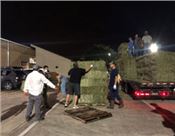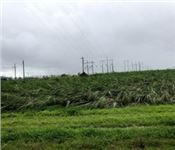LSU AgCenter Assessing Damage From Hurricane Ida, Injury To Agriculture Could Be Extensive
BATON ROUGE, LA.
LSU AgCenter agents are beginning the arduous task of damage assessment and recovery from Hurricane Ida.
Given the geographic area affected, the biggest economic impact is likely to be to agricultural infrastructure and timber, said Kurt Guidry, LSU AgCenter region director and agricultural economist. But sugarcane, livestock, soybeans, fruit and vegetable crops, and the horticulture industry also experienced losses.
“If you draw a line from Terrebonne Parish north to the Felicianas, everything east will see some damage,” Guidry said.
It is too early to get a true damage assessment, but Guidry suspects some of the infrastructure loss caused by Ida will be similar to what the southwestern portion of the state experienced with Hurricane Laura in 2020.
“We are getting reports of significant damage to fencing, buildings and farm structures,” he said.
Sugarcane is grown throughout the impacted area. Louisiana has approximately 500,000 acres of sugarcane, up to 25 percent of which may be affected by Ida, said AgCenter sugarcane specialist Kenneth Gravois.
The sugarcane crop in the southwestern part of the state was spared, he said, but damage could vary in the southeast.
“Lodging of sugarcane will have occurred in many places, and that will slow planting,” he said.
The sugarcane harvest is still a few weeks away, and as the weather improves over time, the lodged cane could begin to erect itself, Gravois said.
For cane that is leaning but not broken, farmers will have an easier time harvesting, Guidry said. But in areas where Ida’s winds flattened the crop, harvesting will be difficult and sugar recovery will be lowered.
Renee Castro, an AgCenter area sugarcane agent who covers much of the affected area, said the cane is flat in Lafourche Parish.
Looking at possible timber damage, Guidry estimates that the region represents about 5 percent to as high as 22 percent of total production in Louisiana. Flyovers by the Louisiana Department of Agriculture and Forestry will determine losses.
Guidry said there are about 172,000 head of cattle in southeast Louisiana, and agencies are working to get them watered and fed.
Dr. Christine Navarre, AgCenter extension veterinarian, said a multiagency team consisting of the AgCenter, Louisiana Farm Bureau Federation, Louisiana Department of Agriculture and Forestry, LSU School of Veterinary Medicine, Louisiana Tech University, the Louisiana Cattlemen’s Association and other livestock groups are working to get needed resources to impacted animals.
“Tuesday night, 1,200 square bales of hay were delivered to the Louis Mouch Jr. Multi-Purpose Facility in Port Allen and to the LSU School of Veterinary Medicine,” Navarre said. “Many volunteers showed up to help unload.”
Most of the hay was distributed, and she said other supplies are being collected and distribution locations are being identified farther east and south.
Navarre said anyone requesting or donating hay, feed, pasture or trucking should go to https://lafarmbureau.org/hayclearinghouse. For requests for other assistance, contact your local LSU AgCenter agents, Farm Bureau agents or local office of emergency preparedness.
Navarre thanked members of the Texas A&M Veterinary Emergency Response Team for organizing these donations, Texas Equine Veterinary Association, The Foundation for the Horse (part of the American Association of Equine Practitioners) and Nutrena for donating feed and trucking, and JB Hunt Trucking for also assisting with the donation.
Rusty Gaude, an AgCenter area fisheries and Louisiana Sea Grant agent in Jefferson Parish, said his area has been hit hard.
“As with other storms, the fishery resources are probably OK,” Gaude said. “The means to harvest such are what is unknown.” ∆

Volunteers help to distribute hay donated for livestock affected by Hurricane Ida.
Photo by Christine Navarre/LSU AgCenter

Downed cane along River Road in West Baton Rouge Parish following Hurricane Ida. The cane looks to be compromised but it is capable of righting itself and will be harvested with little to no loss.
Photo by Sam Irwin/American Sugar Cane League